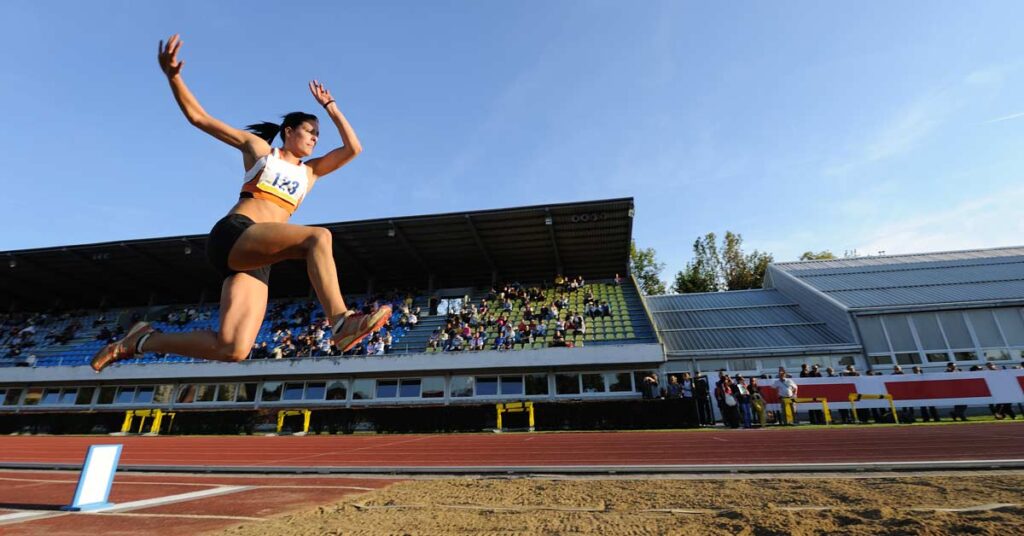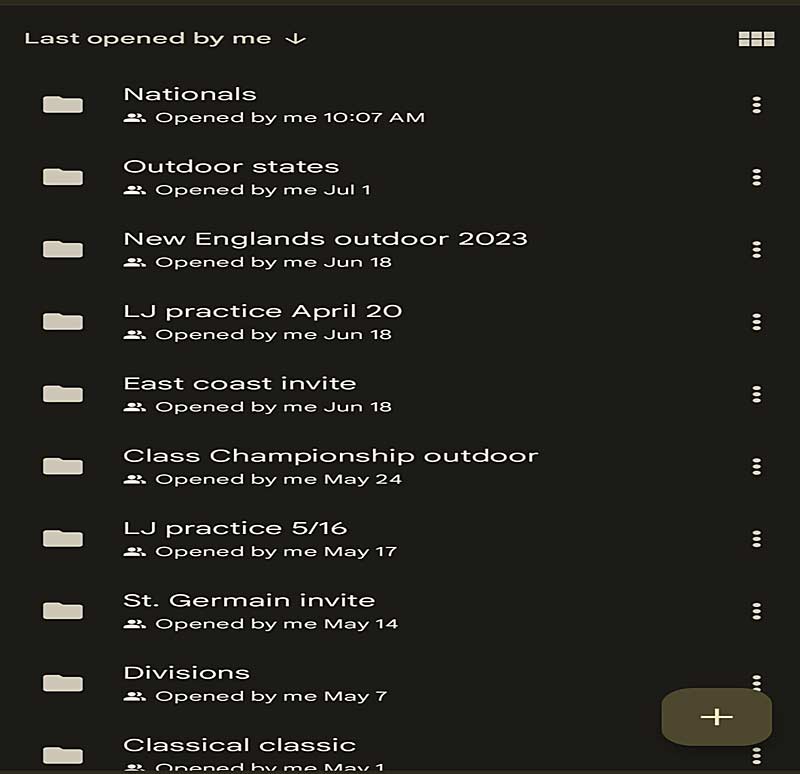
Too often, I find myself watching cringe-worthy jumping at high school track meets. I see talented athletes not coming close to what they are capable of in the jump events due to dangerous or incorrect techniques and jump strategies.
Behind every poorly taught jumper is a track coach who has not studied the discipline or even done the bare minimum to teach the event safely. Unfortunately, in the state where I coach, the jumps are treated as second-class events compared to the sprints and distance events; this is further underscored when big competitions are held at tracks with damaged runways, unlevel boards, and neglected sand pits.
I encourage all coaches to start to film the jumpers on their team performing and later review the film with the athletes—I guarantee it will help you as much as it has helped with my team. Share on XI have spent a lot of time researching and reading the writings of coaches and researchers who have put out information on the jumps, which has helped me immensely as a coach. More recently, I’ve been trying to figure out the next step in my career that would take my coaching abilities to a higher level. Reviewing films has been that next step. I encourage all coaches to start to film the jumpers on your team performing and later review the film with the athletes (or have the athletes film themselves)—I guarantee it will help you as much as it has helped with my team.
Improvements in Coaching
I do not have as good of a coaching eye as some other, more experienced coaches. I can typically focus on one, maybe two things on each jump…which leaves a lot more to be missed than to be seen. Filming practices and competition when appropriate has made me a much better coach. When you constantly watch film, you learn far more about each athlete’s strengths and weaknesses. I have also found errors in athletes’ techniques in places I would never have noticed had I not filmed and slowed the film down to watch it.
Watching jumping in slow motion or reverse opens the mind to how the athlete truly moves down the runway. I had the pleasure of coaching the long jump State Champion and New England Champion this past season. He started the season jumping 21’7” and ended up jumping 23’10¼” at the state championship, setting a state meet record. This improvement would never have happened if the athlete and I had not reviewed his film together.
Video 1. This was the first film session of our indoor season: the jump was 21’7”. A few weeks later, the athlete jumped 23’10”.
The best strategy for film review is to pick the most needed technical change that will give you the biggest return on investment. I thought the athlete above had a very solid approach run, but they over-lowered a bit on the penultimate step; however, this was not what was holding the athlete back from bigger jumps. The primary errors I identified that would give us the biggest ROI were the in-air and landing mechanics. The huge arch in the back is there to counter forward rotations (incorrectly), but it is so overdone that the athlete seems to create backward rotation. They then end up stabbing the sand with extended legs and crashing their thighs into the pit, which in my estimation, loses them at least 18 inches off their jump.
The best strategy for film review is to pick the most needed technical change that will give you the biggest return on investment, says KCPerformance_. Share on XTo improve the in-air and landing mechanics, we simply practiced jumping into the pit off of a short approach and ensuring that the head, spine, and hips were aligned in the air before landing. We also focused on cycling the arms and legs in a way that did not cause any loss of posture and set a rhythm for the athlete to prepare for the landing in time. Without fixing the posture as the athlete traveled through the air, we could not fix the landing. Most problems are caused by the part of the jump that preceded it.
We then moved on to the landing phase, timing the arm and leg action prior to landing and making sure the athlete was able to sweep his arms behind him as he extended his legs. Once the feet contacted the sand pit, the athlete was instructed to let his legs relax and bend into the landing. This allowed the athlete’s hips to pass over the feet, so there would be minimal loss of distance due to the landing. Not every jump will be perfect—sometimes old habits reemerge—but as the season progresses, these old habits should be seen less frequently and eventually totally eliminated.
Video 2. At Nike Nationals: When athletes are aware of their KPIs, sometimes you don’t even have to add notes—they already know what to look for.
Film Sessions
I always look to other track events and even team sports to see what programs and coaches are doing that make their teams successful. A recent idea I began using from American football was the idea of “film sessions,” aka breaking down game film. If you played football, at least at the high school level, this is nothing new or earth-shattering. Film sessions have always been a big part of many football programs and are usually held a day or two after a Friday night or Saturday morning game. There is usually film of the previous game, and coaches review or break down plays, formations, and the execution of game strategies.
This past season, I began filming our jumpers in practice and competition and later showing them the film of how they executed their jumps—filming the athletes jumping helped build buy-in and allowed athletes to become a part of the learning process. I discovered that if athletes can see what their jump looks like and are taught what they are doing well and what they need to improve, they understand the value of better technique.
If athletes can see what their jump looks like and are taught what they are doing well and what they need to improve, they understand the value of better technique, says KCPerformance_. Share on X
Budget-Friendly Video Editing
I specifically chose my words carefully and called the prior section “Film Sessions” rather than “Film Analysis” because I believe film analysis has more metrics and data that go along with it. I also do film analysis, but when it comes to breaking down film for my athletes, I think that adding ground contact times, flight times, and take-off angles is very heavy for practice sessions with high school athletes. The athletes I work with are very intelligent and creative; I’m sure they are very capable of learning about these metrics, but as of now, I keep an eye on these metrics and usually keep them to myself unless it is absolutely necessary to bring them to the athlete’s attention.
When I do perform film analysis (I use DartFish Express), it is very helpful for collecting certain metrics, but I feel it is limited for breaking down film and getting creative. I am not a very art-inclined person, but using video editing apps has helped unleash my creative side and also given me a great appreciation for video editing and production.
Video 3. Dartfish has very useful options, like the overlay function.
I used InShot video editor this past indoor and outdoor season and have really grown to enjoy it. You can download it from the Apple and Android app stores for free. Most people have a smartphone already, so considering the app is free, there really is no financial barrier to using this method.
My favorite uses of InShot are to slow video down, freeze frame, zoom in, and add notes directly into the video. I typically slow videos down and freeze them on certain parts of the video where important technical components exist (approach, transition phase, penultimate step, take-off step, in-air mechanics and landing). As the season progresses and technique improves, our points of emphasis shift, and we are usually more focused on certain technical aspects that may be lagging or some key performance indicators that the athlete and I have targeted for improvement.
For example, if the coach and athlete agree that a point of emphasis should be the last four steps of the approach, you can edit the video to slow it down and freeze it on that part of the jump in order to give feedback. It is one thing to tell an athlete they are doing a better jump—but actually showing improvements visually is a game-changer.
Video 4. Athletes love seeing their improvement, usually because a better technical jump is more visually appealing on video, and a personal best performance usually accompanies it.
Athlete Buy-In
Athletes really do become part of the process when you start sharing videos with them. Early in my coaching career, I struggled with getting kids to fully understand what they were supposed to do when jumping. I was never precisely on the same page with athletes until we started breaking down film together. Now, the athletes know exactly what the goal is and what they are doing to to try to execute their jumps. The kids are excited to see themselves jump, and if I don’t upload their videos within 24 hours, I usually receive texts from eager athletes asking when those will be uploaded.
If you do this right, athletes will look forward to film sessions, and those who really buy in will end up becoming students of the event. I truly see some jumpers actively trying to master their craft. Several of my veteran athletes learned so much from our film sessions that they ended up helping coach our less-experienced jumpers, which was awesome to see. Film sessions are there to support the athlete and offer positive, constructive criticism—they are not meant to nitpick and put someone on blast. At the end of the day, these events are tough to succeed in, and the athletes are giving their best effort, which is all a coach can ask for.
Film sessions are there to support the athlete and offer positive, constructive criticism—they are not meant to nitpick and put someone on blast, says KCPerformance_. Share on X
Sharing the Video Clips
The best way I’ve found to share videos with my team is by uploading the film to Google Drive. I organize films by creating folders for every meet, as well as certain practices. I share the film with each athlete and name each video so they know precisely what jump attempt from each meet the video contains. After one indoor and outdoor season, I have already built a decent database of jump videos. Watching the jumpers progress and compare their performances with the videos has been a game-changer for our program. Breaking down film has also been a great way to generate conversation about the meet in person or through text.

Film When It Makes the Most Sense
Inexperienced jumpers spend the better part of a season learning the event. I always tell my athletes not to worry about the distance they jump in practice. I work hard to create a learning environment because I want the athletes to focus on improving their technique in a way that feels natural and stress-free.
I do not immediately put a camera in the face of a newbie jumper and start showing them film of their every jump—beginners need more experience before I start breaking down film with them. For them, I greatly emphasize the fundamentals and not worrying about adding anything advanced. I believe forcing someone to watch themselves jump too early in their career can be very overwhelming.
For a new jumper, at first, I just want them to learn and have fun. Once they start developing a passion for the event, that’s when we can start breaking down film. The best way to introduce a film session with a new jumper is to let them ask you to film them and watch—if they initiate it, that means they are interested.
Video 5. This is a simple video with a lot of positive reinforcement early in the season.
Keep It Simple
I try not to overcomplicate the feedback I provide to jumpers—the best videos I create are the ones I keep simple, with minimal writing. Sometimes I struggle with giving too much feedback at certain points. It is something I am actively working on improving. I notice that the fewer words I use, the better and more understandable the feedback is.
I try not to overcomplicate the feedback I provide to jumpers—the best videos I create are the ones I keep simple, with minimal writing, says KCPerformance_. Share on XAt times, I’ve used a GoPro on a tripod stand with a remote to film—this is helpful, but I have also had a lot of success just filming on my phone. I sometimes film a jump and immediately show the athlete to give some instant feedback and let them see what happened. It’s important to know when it’s the right time to watch a film immediately with an athlete. I try my best not to be stuck behind my phone screen because I don’t like missing attempts.
Video 6. Breaking down film is helpful for even post-collegiate-level athletes.
Results to Back It Up
This past season I had five jumpers from our team qualify for the state championship in their respective jumping events. I also had three jumpers finish in the top 10 at the state championship, with one of them being the State Champion and New England Champion and state meet record-holder.
A big part of the success of our jumpers was because we broke down film, taught our jumpers to take ownership of their technique, and fostered an environment for people who wanted to master their craft. I hope this article has encouraged coaches to take the next step in their coaching journey and learn how to break down film. Use these tips to help guide you and watch your jumpers evolve!
Since you’re here…
…we have a small favor to ask. More people are reading SimpliFaster than ever, and each week we bring you compelling content from coaches, sport scientists, and physiotherapists who are devoted to building better athletes. Please take a moment to share the articles on social media, engage the authors with questions and comments below, and link to articles when appropriate if you have a blog or participate on forums of related topics. — SF


So right! and so much needed!
key words: dangerous, inexperience, technique
Speed kills! in poor jumping and nice marks, even excellent ones over shadowed by a a lack of seeking for knowledge. I’m so fortunate that my state- Georgia has improved coaching at every level.
I’m not famous, but my resume and history has exceeded most jump coaches. 6yrs at DI, multiple years at programs that just didn’t have talents on the runway. Currently, several 9-11 graders passing some Dl marks. Bragging? paid my dues, lots of coaches ed, S&C, colleagues and mentors!
You guys are where success begins for any “seeker” coach. The tj is beautiful but deadly if unprepared. The hj remains the most neglected field event (my view)
simply faster it’s worth the $$$ Thank you for this article bro
Thanks for reading Mike, glad you enjoyed it.
It’s a shame that young athletes are half haphazardly thrown into jumping events without proper guidance. I have unfortunately seen it with pole vault as well…